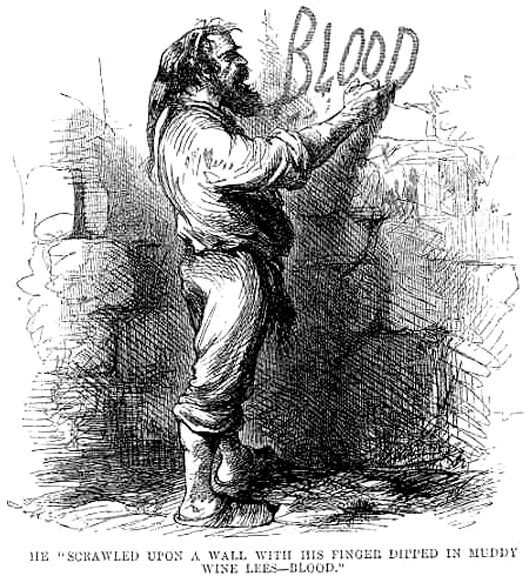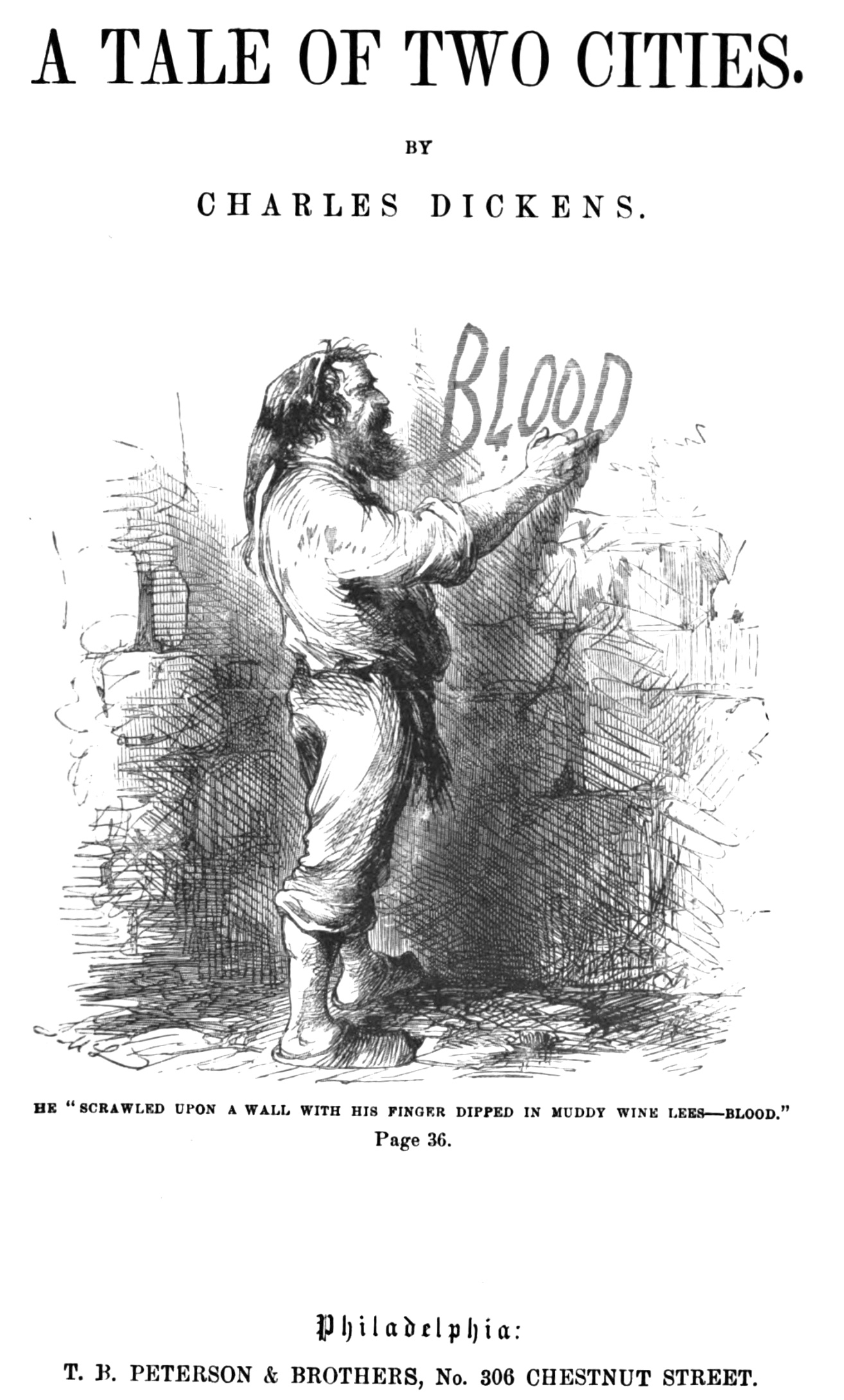

He "scrawled upon a wall with his finger dipped in muddy wine lees — blood." — fourth regular illustration for "Dickens's A Tale of Two Cities, Book I, Chapter 5, "The Wine-shop"; the text was first published in the All the Year Round number for 14 May 1859. This instalment, with the present illustration, first appeared in the 21 May 1859 issue of Harper's Weekly, p. 325. It was reproduced in the T. B. Peterson (Philadephia) volume as the title-page vignette. Wood-engraving: 8.3 cm high by 8.5 cm wide (3 ¼ by 3 ⅜ inches, vignetted, by John McLenan. [Click on illustration to enlarge it.] The illustrations appearing here are courtesy of the E. J. Pratt Fine Arts Library, University of Toronto, and the Irving K. Barber Learning Centre, University of British Columbia.
Passage Illustrated: A Prophetic Warning of Future Large-scale Bloodshed
The wine was red wine, and had stained the ground of the narrow street in the suburb of Saint Antoine, in Paris, where it was spilled. It had stained many hands, too, and many faces, and many naked feet, and many wooden shoes. The hands of the man who sawed the wood, left red marks on the billets; and the forehead of the woman who nursed her baby, was stained with the stain of the old rag she wound about her head again. Those who had been greedy with the staves of the cask, had acquired a tigerish smear about the mouth; and one tall joker so besmirched, his head more out of a long squalid bag of a nightcap than in it, scrawled upon a wall with his finger dipped in muddy wine-lees — blood. [Book the First, "Recalled to Life," Chapter V, "The Wine-shop," 325]
Commentary: Gaspard, "one tall joker," prophesies the annihilation of the aristocracy.
Gaspard, the witty wood-sawyer, epitomizes the poverty and privation of St. Antoine, the proletarian suburb beyond the Bastille. In him, Dickens particularizes how the desperate urbanites of the initial vignette will respond when circumstances give them the opportunity to eradicate the aristocracy. The wine's running in the streets symbolizes the widespread carnage of the violent mob scenes and public executions of the opening stages of the French Revolution in which the Defarges, The Vengeance, and Gaspard will play no small part in Dickens's historical novel.
Other Illustrated Editions (1859-1910)
- Hablot K. Brown or 'Phiz' (16 illustrations, 1859)
- Sol Eytinge, Junior (8 illustrations, 1867)
- Fred Barnard (25 illustrations, 1874)
- A. A. Dixon (12 illustrations, 1905)
- Harry Furniss (32 illustrations, 1910)
Related Material
- John McLenan's Thirty-One Headnote Vignettes for A Tale of Two Cities in Harper's Weekly (7 May — 3 December 1859)
- McLenan's and Phiz's Illustrations for
A Tale of Two Cities (1859): A Correspondence?
- Images of the French Revolution from Various Editions of A Tale of Two Cities (1859-1910)
- French Revolution
- Victorian Images of the French Revolution
- "A Tale of Two Cities (1859): A Model of the Integration of History and Literature"
Scanned image and text by Philip V. Allingham. [You may use this image without prior permission for any scholarly or educational purpose as long as you (1) credit the person who scanned the image and (2) link your document to this URL.]
Bibliography
Allingham, Philip V. "Charles Dickens's A Tale of Two Cities (1859) Illustrated: A Critical Reassessment of Hablot Knight Browne's Accompanying Plates." Dickens Studies. 33 (2003): 109-158.
Dickens, Charles. A Tale of Two Cities. Illustrated by Phiz (Hablot Knight Browne). London: Chapman and Hall, 21 November 1859.
Dickens, Charles. A Tale of Two Cities. Illustrated by John McLenan. Harper's Weekly: A Journal of Civilization, 7 May through 3 December 1859.
Dickens, Charles. A Tale of Two Cities. Illustrated by John McLenan (33 illustrations). Philadelphia: T. B. Peterson, 1859.
Dickens, Charles. A Tale of Two Cities: A story of the French Revolution. Project Gutenberg e-text by Judith Boss, Omaha, Nebraska. Release Date: September 25, 2004 [EBook #98].
Dickens, Charles. A Tale of Two Cities. With illustrations by John McLenan and Rowland Wheelwright. Orinda, Cal.: Sea Wolf Press, 2021.
Created 5 August 2007
Last modified 24 November 2025